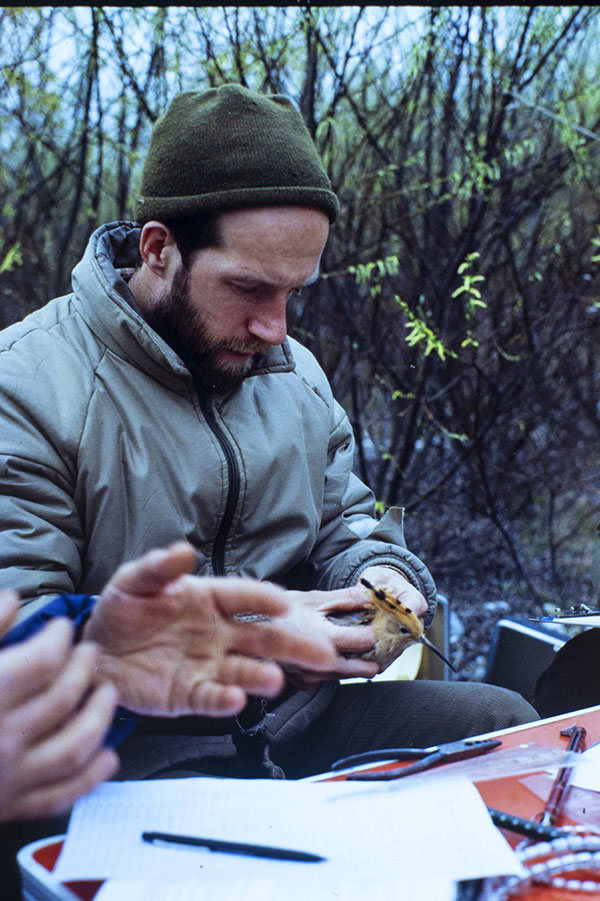GIANCARLO FRACASSO
Reading Time: 6 minutes
Maggio 1983, loc. Friola – Pozzoleone – Vicenza – I
Nel panorama ornitologico, Giancarlo Fracasso non ha bisogno di presentazione.
Passo quindi a fare due chiacchiere con lui, contento che abbia risposto positivamente alla mia richiesta, non fosse altro in nome dell’amicizia che ci lega ormai da più di trent’anni.
Giancarlo, ci racconti come hai iniziato ad interessarti alla bioacustica?
La cosa si perde nella notte dei tempi e coincide con gli inizi un po’ più “razionali” e meno infantili dei miei interessi per gli animali ed in particolare per gli uccelli. I ricordi sono ovviamente un po’ vaghi ma almeno ho delle tracce “documentate”, perché dal 1962 (per imitare mio fratello di poco maggiore di me) ho iniziato un diario, certo non per velleità autobiografiche, per carità, ma solo per banalissime osservazioni di uccelli. Tra le carte mi ritrovo, accuratamente conservato, un articolo di una rivista medica (“Panorama medico” maggio-giugno 1963) che mio padre, ormai conscio di dove mi stavo cacciando…, mi aveva ritagliato e passato. E’ stato un articolo illuminante, firmato da Gerhard Thielcke, che poi ritroverò spesso nelle pubblicazioni ornitologico-biacustiche tra gli anni ’60 e ’80, e che sintetizzava le sue ricerche sui dialetti degli uccelli, ma soprattutto illustrava il testo con una bella serie di sonogrammi di strofe di fringuello, luì piccolo e rampichino alpestre. Da quel momento è iniziata una fascinazione, forse un po’ troppo di tipo “estetico”, per i sonogrammi, che mi è sempre rimasta in testa, come qualcosa che dovevo assolutamente riuscire a fare anch’io! C’è voluto qualche decennio…
Quali attrezzature utilizzi?
Da autodidatta, molto ignorante e con scarsissime “disponibilità”, ho faticato molto a procurarmi della strumentazione adatta. A partire sempre dal 1963 ho cominciato (ancora per merito/ispirazione di mio padre) ad abbonarmi a riviste ornitologiche di un certo livello (a partire dal Journal fuer Ornithologie, poi Alauda, Ibis ecc) dove ho cominciato a scoprire l’uso di parabole, microfoni direzionali, super-registratori, sonografi ecc ecc. Tutte cose per me inarrivabili e introvabili. Verso la fine degli anni ’60 avevo tentato invano di procurarmi la famosa “Grampian” inglese (relativamente economica, ma non abbastanza…) che vedevo molto usata a quel tempo, o peggio ancora la costosissima (per me) “Dan Gibson” già trasparente (vera antesignana). Solo nell’estate del 1971 sono riuscito a procurarmi l’economica ma grezzissima “Roché”. Un’affare di 90 cm di diametro e pesantissimo, peggiorato da una struttura primitiva che mi è toccato arrabattare per sostenere nel fuoco un microfono. Però, sia quest’ultimo (proprio una robetta racattata in un negozio di materiale elettrico), sia il registratore (un Grundig a nastro, portatile e anche quello sul pesantino) non proprio il top… e con risultati proporzionati. Ho passato ancora diversi anni prima di potermi permettere qualcosa di decente, il 1976 quando ho preso un Uher 4000 e un microfono Sennheiser dinamico. Quello stesso anno ho conosciuto (ormai finiti gli studi, purtroppo) Sergio Frugis all’Università di Parma (una svolta nella mia vita….) a cui, per presentarmi con qualcosa di “ornitologico”, feci ascoltare una registrazione (non proprio malvagia) di capinera che gli piacque molto (o almeno fu così gentile e paziente da farmelo credere…). E adesso? Be’, grazie a te…, mi son messo a “collezionare”, più che registrazioni purtroppo, registratori digitali di tutti i tipi (entro i limiti di un budget ragionevole), naturalmente parabole microfoniche Telinga e successivi modelli, sempre attraverso te.
C’è una specie o un gruppo di specie alle quali sei particolarmente legato?
Principalmente Passeriformi, soprattutto quelle specie coi canti (o versi) relativamente semplici, insomma quelli che danno i sonogrammi secondo me più facilmente leggibili, più “belli” insomma ( e ci risiamo…)
Sei più incline al paesaggio sonoro o ad altri tipi di registrazioni?
No, paesaggi sonori proprio no!
Pensi che ci sia abbastanza interesse per i canti e i richiami degli uccelli da parte di coloro che sono interessati all’ornitologia?
C’è stato un lunghissimo disinteresse, quasi totale, ma le cose sono certamente cambiate recentemente, ma è un campo che, penso, difficilmente attirerà molto, perché da una parte ai birdwatcher interessa fin tanto che serve all’identificazione e al reperimento di questa o quella specie (rara possibilmente, e magari soprattutto col playback), mentre ai professionisti/ricercatori/accademici non mi pare offra allettanti prospettive: altri settori “tirano” e probabilmente “rendono” molto di più, diciamo in termini di “lavoro”, almeno di questi tempi.
____________________________________________________________________________________________________
English version
In the ornithological panorama, Giancarlo Fracasso needs no introduction.
So I go to have a chat with him, glad that he responded positively to my request, if only in the name of the friendship that has binded us for more than thirty years.
Giancarlo, can you tell us how did you get interested in bioacoustics?
This is lost in the mists of time and coincides with the slightly more “rational” and less childish beginnings of my interests in animals and in particular in birds. The memories are obviously a bit vague but at least I have some “documented” traces, because since 1962 (to imitate my brother who is a little older than me) I started a diary, certainly not out of autobiographical ambitions, for heaven’s sake, but only for very banal observations of birds. Among the papers I find, carefully preserved, an article from a medical journal (“Panorama medico” May-June 1963) that my father, now aware of where I was heading …, had cut out and passed on to me. It was an illuminating article, signed by Gerhard Thielcke, which I later found often in ornithological-bi-acoustic publications between the 60s and 80s, and which summarized his research on bird dialects, but above all illustrated the text with a beautiful series of sonograms of Chaffinch, Common chiffchaff and Eurasian Treecreeper. From that moment began a fascination, perhaps a little too “aesthetic”, for sonograms, which has always remained in my head, as something that I absolutely had to be able to do too! It took a few decades …
What equipment do you use?
As a self-taught, very ignorant and with very little “availability”, I struggled a lot to get the right equipment. Also starting from 1963 I began (again thanks to my father’s inspiration) to subscribe to ornithological journals of a certain level (starting from the Journal fuer Ornithologie, then Alauda, Ibis etc.) where I began to discover the use of parables , directional microphones, super-recorders, sonographs, etc. All things for me unattainable and unobtainable. Towards the end of the 60’s I had tried in vain to get the famous English “Grampian” (relatively cheap, but not enough …) that I saw used a lot at the time, or worse still the very expensive (for me) “Dan Gibson” already transparent (true forerunner). Only in the summer of 1971 did I manage to get the cheap but very raw “Roché”. A business of 90 cm in diameter and very heavy, made worse by a primitive structure that I had to strive to support a microphone in the fire. However, both the latter (just a piece of stuff picked up in an electrical shop), and the recorder (a Grundig tape, portable and also the one on the weight) is not really the top … and with proportionate results. I spent several more years before I could afford anything decent, 1976 when I got a Uher 4000 and a dynamic Sennheiser microphone. That same year I met Sergio Frugis at the University of Parma (now finished, unfortunately) (a turning point in my life ….) to whom, to introduce myself with something “ornithological”, I played a recording (not really malvagia) of blackcap which he liked very much (or at least he was kind and patient enough to make me believe it …). And now? Well, thanks to you …, I started to “collect”, more than recordings unfortunately, digital recorders of all kinds (within the limits of a reasonable budget), of course Telinga microphone dishes and subsequent models, again through you .
Is there a species or group of species that you are particularly attached to?
Mainly Passeriformes, especially those species with relatively simple songs (or verses), in short, those that give the sonograms in my opinion more easily readable, more “beautiful” in short (and here we go again …)
Are you more prone to soundscapes or other types of recordings?
Not at all soundscapes!
Do you think there is enough interest in bird songs and calls by those interested in ornithology?
There has been a very long, almost total disinterest, but things have certainly changed recently, but it is a field that, I think, will hardly attract much, because on the one hand, birdwatchers are interested in as long as it serves the identification and retrieval of this or that species (possibly rare, and perhaps especially with playback), while to professionals / researchers / academics it does not seem to offer attractive prospects: other sectors “pull” and probably “yield” much more, let’s say in terms of “work” at least these days.

Commenti recenti